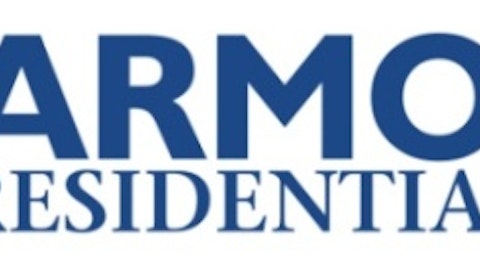My bullishness on Two Harbors Investment Corp (NYSE:TWO) is also shared by the company’s insiders, who have confidence in the company’s future. In fact, during May the company saw 15,000 shares bought (open market) by two of its directors at an average price of $11.46 per share.
ARMOUR biggest loser
ARMOUR Residential REIT, Inc. (NYSE:ARR) has faced tremendous difficulties since the launch of QE3. Its net interest rate spread contracted, causing dividend cuts twice during the prior year. Besides this (or perhaps due to it), the company has depreciated 13% in value since the beginning of the year. This is the worst performance among the Bloomberg index of 33 mREITs.
Recently, ARMOUR Residential REIT, Inc. (NYSE:ARR) raised equity, which was used to finance new production MBS, which perform better during a low interest rate environment. However, these bonds perform worse when rates go up. ARMOUR Residential REIT, Inc. (NYSE:ARR) has built a portfolio that will not benefit from a rising interest rate environment. In fact, you can expect the company to report around 4% drop in its net interest rate, if the interest rates go up by 50 bps.
The case in not different at Javelin Mortgage Investment Corp (NYSE:JMI), which was also founded by Ulm and Zimmer, who founded ARMOUR Residential REIT, Inc. (NYSE:ARR). Javelin Mortgage Investment Corp (NYSE:JMI) is currently the second-worst performer among mREITs. JAVELIN is like ARMOUR Residential REIT, Inc. (NYSE:ARR), but it’s allowed to invest in non-Agency bonds, such as subprime debt. This helps the company diversify its risk and exposures to changes in interest rates and the Fed’s interventions.
Unlike Invesco Mortgage Capital Inc (NYSE:IVR), JAVELIN’s sole source of funding is through the repo markets. Given JAVELIN’s high leverage of 7.9 times and a cost of funds of 1.03%, any disruptions in the repo markets could have a magnified impact on the company’s sources of funding.
With a 50 bps increase in the interest rates, you can expect the company to report around 8% decline in its net interest income. This is troublesome, particularly when analysts in general are anticipating volatility in the interest rates as the Fed weighs an exit.
The article The Best and Worst mREITs Amid the Fed’s Exit originally appeared on Fool.com.
Adnan Khan has no position in any stocks mentioned. The Motley Fool has no position in any of the stocks mentioned. Adnan is a member of The Motley Fool Blog Network — entries represent the personal opinion of the blogger and are not formally edited.
Copyright © 1995 – 2013 The Motley Fool, LLC. All rights reserved. The Motley Fool has a disclosure policy.



